Thursday, September 28, 2006
For Katie
We've been on the lookout for all these things. So far we've only found one. So here it is, Katie. Thanks for the comments.
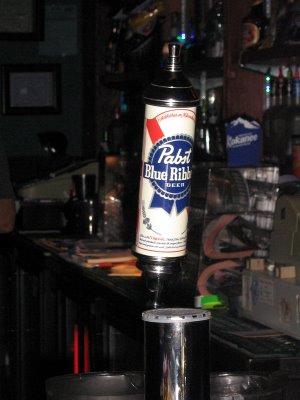
Gin-u-wine PBR on tap at The Grail, one of the sleaziest (read: cement gargoyles out front, bad rap music bumping inside, four patrons, one chunky girl beer-bonging it while standing on the bar) Coeur D'Alene, Idaho.
Wednesday, September 27, 2006
Where Banjo lived and where Wolfman died
We headed out of Washington on September 24, headed to Coeur D’Alene, Id. and my friend C., where we found death and beauty in equal measures.
C. lived in Chico and Paradise for a long time, attending Chico State University for his business and finance degree, but he was raised in various places in Idaho. He used to tell us all these stories about the rugged, rural lifestyle, like doing e-brake 360s on icy driveways in pickup trucks. I had never been to Idaho, so I could only imagine what any of these stories actually looked like.
But finally we had arrived. After trekking across the part of eastern Washington that looks suspiciously like California’s central valley...
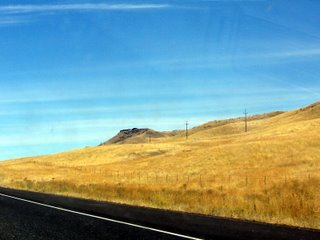
...we crossed the border and began to see the thick strands of towering pines, the immense, glassy lakes and huge, smoky hills.
The other thing we immediately began to see were housing developments. Farmland is being consumed at a rapid rate by huge, square colonies of homogeneous homes and scraggly deciduous saplings. This is a land tamed by loggers and farmers, where everybody hunts, where people own huge, lifted pickups and two quad runners just for that purpose. Still, somehow, the architects dictate that the ideal community is something like Levittown on steroids—flat tracts, square streets, tiny backyards. If anything is going to tame Idaho, it’s the housing. As we drove through Coeur D’Alene and its neighboring burgs, C. pointed out the potato and wheat fields that the farmers no longer own, cultivated by the developers until they feel like paving them over; the lumber mill quietly awaiting demolition to make way for more three-bedroom Shangri-Las.
This is a land where they race riding lawnmowers (that episode of "King of the Hill" is grounded in reality), where each town has its own amateur stock car league, where muzzleloader season leads into bowhunting season, which leads into rifle hunting season.
And they hate Californians. The last decade has seen a tremendous influx of the West Coasters seeking a more relaxed rural life (or perhaps just a decent price on a home larger than a breadbox).
“Lots of them, if they see you have a California license plate, will flip you off,” C. told us, glad that he got Idaho plates on his new car.
Moreover, Idaho is a conservative bastion, rife with George Bush bumper stickers. Likely they see Californians as liberal invaders.
Nonetheless, the Californians are coming—and millionaires from all around. Coeur D’Alene is refashioning itself into an upper-end resort town. It already boasts the longest floating boardwalk in the world—3,300 feet—on the shore of Lake Coeur D’Alene, where multi-hundred-thousand-dollar powerboats float tantalizingly close.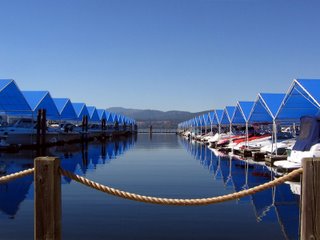
High-rise condominiums are shooting up downtown, and along a golf course with a legendary floating green, one developer is building two towering condo buildings which will offer units for $6 million apiece along with an agreement to pay an annual $160,000 membership fee for the course.
They’re numbers that boggle my mind. Obviously I don’t think like a millionaire, but the thought of spending more than the annual income of an upper-middle-class family so some teenager can open a fancy gate to let me onto a giant lawn makes me cringe. I will admit it: I don’t know the true nature of extravagance, but I still think I could put that $160,000 to better use each year.
Before we get to the Idaho wilderness, I should explain that 85 percent of C.'s stories involve death, murder, disfiguration, or some combination of the three. As part of his Coeur D'Alene tour, he showed us the Denny's where in 2005, authorities caught up with Joseph Edward Duncan III, who allegedly murdered a mother, a father and one of their sons before kidnapping their other son and daughter.
"He's right in there," C. said that day when we drove past the Kootenai County Public Safety Building, "in a holding cell awaiting trial."
"What's the holdup?" Val asked.
"They're trying to get an unbiased jury together," C. said, "which is hard, because everybody's heard of it. It was out as an Amber Alert when he kidnapped that girl. In fact, if you look around on the cars here, everyone's got a bumper sticker that says 'Kill Duncan.' That's what it's all about."
None of us said anything for a minute.
"He's going to die," C. said.
"He deserves to," I said.
"Yeah, but the thing is, he's not going to get a fair trial here."
"So why don't they move the trial?" Val asked.
"Nobody cares," C. said. "He knows what he did, and he didn't ask for it to be moved. He doesn't care, either."
After Monday’s tour of Coeur D’Alene, on Tuesday we drove north to explore a wilder Idaho where C. spent his early years. Highway 95 took us up across Lake Pen d’Oreille, a massive, cold lake deep enough for the Navy to allegedly test submarines.
In Sanpoint we saw the Litehouse Dressing Bleu Cheese Factory. C. told us how the famous dressing company got its start as a lakefront restaurant before its owners chose to focus just on the condiments.
We headed farther north, out past the towns with supermarkets and into country where the boomingest business is ranching and custom butchering. Out here the primary product seems to be old trucks. Every yard, lot and quarry is full of them.
The land here is beautiful, nestled between towering hills and the Cabinet Mountains, bordering lakes and valleys, all clear and pristine. But it's not fancy living.C. summed it up, classified ad-style: "Beautiful doublewide, on 100 acres, lakeside view. Cinder blocks for your car included."
And we hadn't even reached Clark Fork yet, the dusty little town where C. attended high school. On our way into town we passed a squat stone cabin with a tin roof flying a tattered Confederate flag.
"See that?" C. said. "That's where a former Hell's Angel named Dirty Don lives." Dirty Don, it seems, shot his wife's lover in a bar called Out of Bounds.
"We always called it Out of Bullets," C. said. Ironic.
C. also went to school with Dirty Don's children. DD's son, Banjo (that's not a nickname), dropped out of high school when he was a freshman. Now, C. explained, he drives around town in a huge pickup sporting a thousand-pound homemade wooden bumper with the words "fuck you" painted on it.
As a teenager, C. and his friends like to make acetylene bombs using the welding gas, oxygen and garbage bags.
"You had to walk real carefully with it, because any static spark could set it off," he said. "Then you'd light the fuse and run like hell, because if it went off when you're too close, it could destroy your eardrums."
It's an attempt to be big against the inconceivable bigness of the wilderness. You're big, you're bad. You make the mountains ring with your sound. You make tourists cringe when they see your truck.
Clark Fork is a small, remote town. C. remembers one incident that brought everyone together.
"This guy went missing in the woods, and the entire town went out to search for him," C. said. "We did a grid search of this entire mountain. The whole football team went out there. My dad was on his weekend, and he spent days up there. Finally, after six days, they found him."
"Alive?" Val asked?"Nah," C. said. "He tripped, fell off a cliff and landed on his head."
As we continued on, C. told us we were driving on one of the most dangerous highways in the country. As we passed homemade cross after homemade cross, I saw what he meant. One of the most notable we saw was nestled along the base of a jutting cliff. It was an ankh placed in memory of "WOLFMAN."
Death was even more abundant in Montana, where the state evidently erects a small white cross on a post for each person who died in an accident on the highway. We passed these with alarming frequency, counting seven little crosses in one particularly deadly mile.
“When we were little, we used to count these instead of slugbugs,” C. said, “since there’s no VW Beetles out here.”
What northern Idaho and Montana both have is an almost sickening abundance of breathtaking rugged vistas here. I could photograph every bend in the road. But then we’d never get to whatever sight we’re actually traveling for. I think I ought to have a more sophisticated camera. I think I should have taken photography courses so I might know how to exploit the riches pouring through my viewfinder. But as it stands, I have limited time, limited equipment and limited knowledge. Bear with us, and maybe the thought that it’s Val or me behind the shutter will compensate for the lack of originality or the iffy composition.We drove to see the Ross Creek Cedars, an incongruous forest of the ancient trees amid the pines.
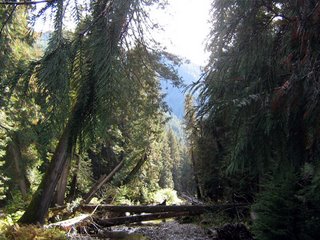
C. remembered visiting them as an elementary school student.
"John Bidwell must have been here," he said.
"Was Bidwell a big Cedar Guy?" I asked.
"No, but he planted every non-native plant under the sun."
After we wandered around in the forest and took a bunch of totally artistic pictures that all turned out like blurred crap, we got back in the car and drove up to what C. called the swinging bridge. This turned out to be Kootenai Falls, a breathtaking view of the Kootenai River along the railroad tracks.
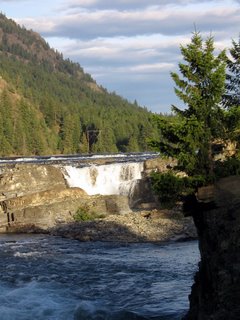
As a bonus, we got to watch a pair of kayakers fight the current and dodge their way through the foam, howling like wild men the whole time.
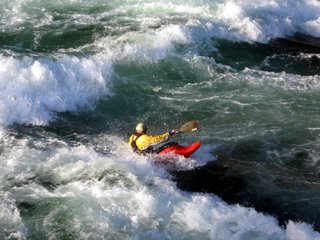
We followed the kayakers downriver, walking on a trail along the cliffside until we came to the swinging bridge C. was talking about. It was a cable suspension bridge spanning the sheer cliffsides of the Kootenai. As we approached, we noticed a sign that said "5 persons maximum." Not exactly encouraging. I hoped Val, C. and I weighed less than the theoretical persons the engineers had calculated for.
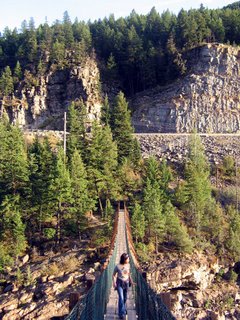
We did.
After walking back across (nervous the whole time about one of us tripping and sending us teetering over the waist-high fencing), we began the drive back to Coeur D'Alene, counting the tiny roadside crosses in the fading light.
Don't litter in Washington
Several times we encountered signs along the freeway with this menacing message: “LITTER AND IT WILL HURT.” These weren’t billboards. They were official Washington State road signs making unclear promises about the consequences for tossing a Burger King wrapper out the window.
“Maybe the sign was designed by environmentalists, and they didn’t realize the last part got cut off,” Val said. “‘Litter and it will hurt the earth.’”
“Or maybe the state is run by the mafia,” I said.
Turns out it’s actually a focus group-tested campaign to reach the people who do litter. The sad truth is that they found the best way to do it is to emphasize the penalty: hefty fines for those who get reported and caught. So think twice before you toss that cigarette out the window on I-90, you sociopath. It could cost you lots of money.
Next up: IDAHO!Saturday, September 23, 2006
Grapes, onions and the rural life

September 22:
We’re just outside Walla Walla now, after being delayed in our departure from Port Orchard.
We took my close friends W. and A. out to lunch Thursday in gratitude for letting us stay with them. They suggested a very nice sandwich shop, where Val had an unfortunate allergic reaction to the nuts in the pear chutney (is there something I don’t know about chutney?). We spent the rest of the day recovering.
By nightfall we were on the road, though. I figured there was no way we would make it to Walla Walla before crashing for the night, so I planned on getting us to Ellensburg, about halfway there.
Beaker snarled up the winding Highway 18 in third gear, passing semis unable to reach 60 mph. It had rained the last few days, but this night it was clear, and the evaporating puddles created clinging rafts of steam just above the roadway. With the thick forest obscuring any ambient light [pollution], things got very eerie.
We finally stopped to eat “dinner” in Cle Elum (looks like some half-assed anagram for something), a town near the summit. It was 9:30, but it felt like 2 a.m. We found a Burger King and sat down to eat. We were the only non-drive-thru patrons. For the rest of the night it would feel as if we were alone in a tarnished fast-food world, reluctant patrons of a vast, surprisingly uncomfortable hospitality machine designed for the massive clans in vans who were all by now in $150-a-night motel rooms they reserved two weeks ago.
I hit the gas as we hit the downhill grade, trying to get to Ellensburg before 11 p.m.
We made it, but only to find the town consisted of two highway offramps and about four hotels, all of which were crammed with gargantuan trucks, buses and station wagons.
“WELCOME CONTRACTORS AND SURVEYORS ASSOCIATION CONFERENCE,” all the marquees in town read. There were white F-250s in every parking lot to prove it, and no single-bed rooms left in the Comfort Inn. The clerk offered us a smoking suite, which we wrinkled our noses at. We finally settled on a local motel, there for 35 years according to the clerk at the neighboring Holiday Inn Express, paying a reduced $72 AAA rate for a room down the longest goddamn hall I have ever seen outside of The Shining. I thought we were going to get lost.
I was anxious to get out of town the next morning. The overpriced hotel room with the tiny TV and no wireless Internet left a bad taste in my mouth. We checked out and looked around. All I saw was offramp sprawl on either side of us. I hear Ellensburg has a beautiful college campus, but I’m less than impressed with the part of town we saw.
We decided to eat in Yakima, just about 40 miles down Interstate 90 from Ellensburg. We drove through hills spotted with scrub brush, past what the map indicated was a military firing zone, and downhill to a plain checked with farmland.
According to its Web site, Yakima is a city of 70,000. They must live underground. All we saw were run-down, single-story residential neighborhoods and a few fast food joints and car dealerships.
And the entire town appeared to have shown up for the Central Washington State Fair. The line of cars waiting to turn left along the choked avenues bordering the fair stretched a good half mile or more. Nearby residents were charging as much for parking space on their lawns—$5— as we would have paid to park near the Space Needle. We did not go to the Yakima Fair.
After we found an Arby’s and had lunch, it was time to get gas. We drove down a street lined with squat buildings selling tractors, used cars and various pawned items, but couldn’t find a single gas station.
“Where the hell do people get gas in this town?” I said.
“Maybe they don’t use gas,” Val said. “Maybe the whole town runs on used cooking oil or something.
“You mean BioDiesel?” I said, looking at the pawn shops and vacant storefronts, remembering the hairy back of a NASCAR hat-wearing man whose thrift-bought Nautica shirt was riding up as he arose from his booth at the Arby’s. “This does not look like a town that cares about BioDiesel.”
Val nodded. “This is a town built on grease,” she said. Then we found the sign leading back to the interstate. We found a gas station, refueled, and on our way out, Val pulled partly into an intersection but didn’t turn left before the light went red. As we sat there waiting for the light to turn again, she pointed to a small black object at the top of the light post.
“Look. It’s one of those traffic cameras,” she said as I wondered whether Big Brother cared if our front wheels were over the crosswalk. I expect to have nightmares about getting recalled to Yakima for traffic court.
After lunch today (and the accompanying feeling of resignation to fast food lunches, both for expediency and economics), we realize perhaps our readership would benefit from a series of restaurant reviews.
The Burger King in Cle Elum was eerie and disappointing. Granted, we ate there half an hour before closing time, but the Swiss & Mushroom Black Angus Burger I ordered was small, skimpy on the mushrooms and lacking crucial pizzazz.
I guess it didn’t matter much, since it felt a little bit like we had stumbled into a restaurant preserved from the apocalypse by its remote forest location. I can’t imagine it would be very easy to enjoy even the choicest BK Black Angus Burger if it was served to you by a hissing albino vampire.
Two stars (one given for a friendly teenage attendant who had to mop the entire floor while we ate).
The Arby’s in Yakima, on the other hand, was surprisingly serene. We ate there at roughly 12:30 p.m., and the place was nearly empty (due, I suspect, to the orgiastic frenzy of the fair). They were offering a “select 5 for $5.95” deal, which I opted for. I got three Arby’s melts, curly fries and a soda. It brought me back to the days when a trip to Chico with my dad would end with us at the Arby’s there, ordering 10 sandwiches during their “5 for $5” deals, dad cringing when the pimply cashier leaned out the window and asked him what kind of sauce he wanted (calling it “horseradish sauce” was generally not specific enough a request to get the “Horsey” sauce we favored).
The restaurants also have some new kind of three-pepper sauce that goes great with curly fries and their roast beef sandwiches. While we ate, one of the cashiers came by with a basket of mints and offered them to us. Truly an extra gesture of classiness.
And classiness can only be a good thing from a restaurant whose idea of menu diversity comes largely from drenching pressed beef slices with nacho cheese.
Val looked at her beef melt sandwich suspiciously and said, “this cheese is a little much, even for me.” She loves nacho cheese.
So, class points for the mints and the bottomless sauce dispensers, trash points for the nacho cheese strategy. All in all, three stars.
***
We arrived in Walla Walla after 4 p.m. and immediately drove to the winery where Val’s friend L. works. We passed scads of sweet onion farms. As Val has told me, the Walla Walla region is the only place where these sweet onions will grow, so it’s become a regional specialty.
But now another specialty is threatening to eclipse the town’s bulby heritage: . There are now more than 70 wineries in the immediate area, up from around 40 just a few years ago. And like the wineries, who offer wine tasting and who see visitors come from as far as Tennessee to try the bottles, Walla Walla itself is beginning to skew upscale.
The downtown area has been nicely renovated. Its historic brick buildings boast an increasing number of boutiques. The chocolate store sells $12 boxes of wine-flavored jelly candies.
But things are much the same as decades past in the fields outside of town.
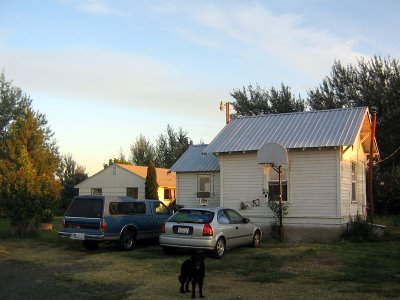 L. lives with her boyfriend and his children in a small house on 10 acres of farmland. They’re starting to raise animals: chickens, pigeons, several cows, four pigs and a horse.
L. lives with her boyfriend and his children in a small house on 10 acres of farmland. They’re starting to raise animals: chickens, pigeons, several cows, four pigs and a horse.They’re also into stock car racing. Up on ramps in the driveway was a battered Buick of indeterminate age. L. said they got it for free from an acquaintance; they plan to race it in October.
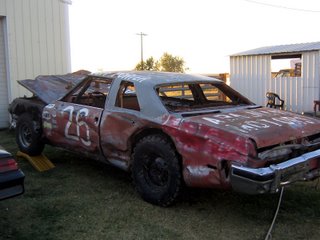
Val took one look and said, “Oh my god, is that moss growing on the rear window sill?”
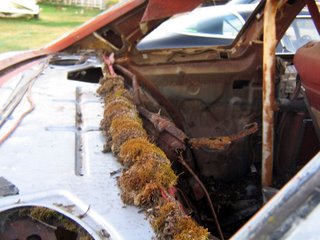
“This is as clean as I’ve seen it,” L. replied. “You should have seen it when we picked it up.”
She took us around the side of their shop and pointed to the racecar graveyard, a cluster of decaying American coupes from the ’70s and ’80s in the tall yellow grass.
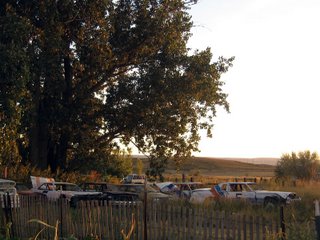
She told us she had been behind the wheel of the latest addition to the wreckage—the car’s rear axle had snapped in the middle of a race.
Later, as the sun set, she took us out to meet the cows and the horse.
“I just love the cows,” L. said. “I never thought I would, but they’re such sweethearts.” She took us out to where the bovines were grazing, her two dogs racing figure-8s around us. True to her description, the cows were friendly, docile animals who sniffed and licked our outstretched hands and then gently nudged our legs with their heads in a bid to get their necks scratched.
V., the teenage daughter of L.’s boyfriend, also came out with us to try to grab the horse. The tall, quiet girl looked a little peculiar in big black galoshes, but as soon as I had dodged my third cow pie, I realized why she wore them.
The horse was finicky and would not be caught. After it bucked past us a few times, V. gave up on the idea.
“Hey, maybe you could show them the trick with the cow,” L. suggested. V. didn’t hesitate. She walked up behind the black and white animal, took five running steps and leaped onto its back. Dik, the most personable of the family’s herd, hardly looked up from his tuft of grass. Then for a moment everyone was silent and still. I was treated to the quixotic silhouette of a lanky, six-foot-tall figure atop a cow, framed by the sunset.
“The only problem is he won’t move,” V. said from her perch.
As we walked back to the house, I asked L. if she had grown up on a farm.
“Oh no,” she said. “I grew up in Sacramento, with big buildings and lots of neighbors. I never thought I’d wind up here.”
She was attending college in Chico when her parents moved to Walla Walla. She met her boyfriend there while visiting them and soon moved up.
“The rural life was mine to choose,” she said, “and I love it.”
***
2 a.m.
We’re blazing down a Washington backroad at 85 mph, chasing after a pickup driven by M., the boyfriend of L., one of Val’s college friends. We’re actually driving L.’s truck, too, for complicated logistical reasons. The little GMC S-15 has plenty of pep, which is good, because we’re chasing a V-8 Silverado with a prison guard on painkillers behind the wheel.
We’re chasing him because he knows the way home and we don’t. It was fine following him on surface streets, since stop signs kept him fairly close, but out here in the boonies, stop signs are scarce. From a previous trip in the daylight, we know these roads are desolate, surrounded by cow pastures and lined with mailboxes so far away from their residences that L. said “people drive four-wheelers to get their mail.”
L.’s boyfriend is on painkillers because he may have broken his elbow. He doesn’t really know. He went to the hospital to get it checked, they gave him a prescription and wrapped it in an ACE bandage, told him to take it easy. He drove from the hospital to meet us out at the bars in Walla Walla, determined not to miss a Friday night with his circle of friends from the correctional facility.
M. managed to pull away from us at the last stop sign, flooring it and racing ahead while I looked both ways before proceeding. Now, as I race to catch up, his taillights disappear. It’s completely dark ahead of the S-15 now, but I know he hasn’t crashed. He’s just gone stealth mode, burning asphalt at 85 with no lights. He knows these roads. I just hope we’re close to their home and no cows are out for a witching-hour constitutional.
We found out M. had hurt himself just a few minutes before we went out to the bars. L. called him and muttered a few shocked words.
M. has had his share of accidents—many broken bones from recreational mishaps. Once, L. explained, he was riding a dirt bike in a field. It flipped and landed on him, breaking his collarbone.
“He was kind of beat up because the bike landed on him and he was afraid he might be bleeding internally, so he decided to take himself to the hospital,” L. said. “But his kids had all gathered at the fence to watch him, so he had to get up and raise his hand to show he was OK. Only he couldn’t raise his hand all the way because of the injury. He told them he had to go to town to get some bread and went to the hospital.”
Another time, L. said, M. had carved her name with a chainsaw in a tree trunk while out cutting firewood. He then cut himself a crude bench in the wood. But something went wrong when he set the chainsaw down, and it cut his knee open. L. likes to joke that the local hospital has a special room for him.
This time, however, the injury was work related. Since L. said M. usually doesn’t like to talk about his experiences at work, we didn’t ask. When we got home, though, he saw my laptop and asked what I was doing. I told him we were working on a blog.
“No more secrets,” he said, and explained to us what happened. More or less. It was some kind of prison scuffle in which he reportedly was defending another guard.
“I bashed the head of a murderer,” M. said, his eyes wide. “He was a convicted murderer. Brought my elbow down on top of his head like this.” He flexed his bicep and dropped his arm in pantomime. “They gave me some medicine and an ACE bandage. I don’t even get any extra pay.”
He sat down on the couch and looked at us, our gear spread out on the coffee table, mattress in the middle of the living room.
“You guys want to write your history, you should stay a week,” he said. “That’s enough time for us to have some history.”
Sunday, September 17, 2006
A little input, please
 but not nearly enough. Here's a giant mechanical Paul Bunyan located at the Trees of Mystery on Highway 101 just south of the Oregon border.
but not nearly enough. Here's a giant mechanical Paul Bunyan located at the Trees of Mystery on Highway 101 just south of the Oregon border.Val whipped Beaker into the parking lot when she spotted the giant animatronic display, jumped out of the car with the camera. Then it started talking to people at its feet.
"Don't be afraid, little girl," it said to one cowering tot. Fifty feet away, Val and I were scared and drove away.
With such a huge world out there, I realize we need some direction, so I turn to you, dear readers. What should we photograph? Comment on this blog entry and tell us some of the roadside things you might want to see. Tell us if there's anything in the northern states between Washington and New York we should visit.
Wednesday, September 06, 2006
Hunting chupacabra in the high desert
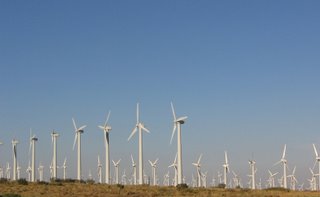
August 17:
We’re standing on an empty road in the hills outside Tehachapi. It’s after midnight and the only lights come from the odd little A-frame in the ranch compound below us and the weird neon blue strobes coming from the forests of gargantuan wind turbines in the distance. The monolithic windmills closer to the compound have no strobe beacons. Their silhouettes tower over Heaven Ranch, blades crying eerily through the night.
We’re about to cross the road and climb a hill toward what our companions are calling an old abandoned slaughterhouse, but we’ve paused because the daughter of Rowdy Roddy Piper is getting second thoughts about leaving the relative safety of the ranch.
I find this a little strange, since she has been vocal about her outdoorsy life in Oregon, but given the reason she’s here at this small compound in the high desert, it makes sense that everyone is a little on edge.
They’re filming a horror movie. Tonight we’re hunting el chupacabra.
Val’s friend is making jokes that since the two of us are the most recent arrivals, we haven’t bonded with the “audience” yet and will be the first two disemboweled by the beast. The Piper’s daughter, a healthy-looking blonde girl of about 20, is remembering all the ghost stories the crew has been telling—about the man who committed suicide in the mobile home where Val and I will sleep tonight, about the little girl who long ago drowned in the gully below the compound when a flash flood tore through the hills and half-buried the graveyard of stolen, stripped cars; how the director once saw her and ordered her to help carry out some equipment, thinking she was his own young daughter.
Her companion, a young man with an enigmatic accent and a movie role, is trying to exploit this as we stumble over a barb-wire fence and weave carefully around the larger tufts of scrub where we’re convinced nests of rattlesnakes slumber.
Val’s other friend, J., mentions mountain lions, and all of a sudden giant cats are dueling it out with venomous snakes in my brain for terror primacy. I shine my flashlight carefully in front of Val’s feet, sure that at any moment I will see a shape that won’t register in my mind as a paw or a slithering tail until after everyone else has started screaming.
Cows graze on these hills, but we see none of them, only dried cow pies. This only increases my puma suspicions. Suddenly Val’s friend lets out a piercing scream and we hear feet shuffling in the loose dirt ahead. The events of the evening suddenly take on a fatal tone as I wonder who should have been leading the group, if we should have been out here with more flashlights, if I should have evaluated the circumstances before we left and been a wet blanket.
Then we hear Val’s friend cursing J. out for scaring her. We press on up the hill, climb over another fence and find a decrepit metal Quonset hut. We peer into it, “Blair Witch” style, to find there’s nothing there—no furniture, no floor, no graffiti. It’s truly empty. Next to the hut we find two decaying cattle trailers. They’re round-roofed wooden things, and they look like the abandoned wagons from a down-on-its-luck carnival.
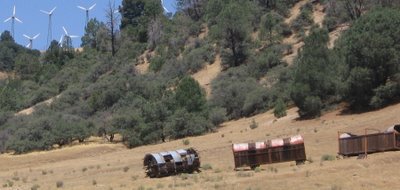
Compelling scenery for a horror movie, but thorough investigation reveals no traces of any kind of human—or vampiric—occupation. This is the high desert.
***
Val and I arrived at the ranch a few hours earlier after driving from Butte County. The opening leg of our West Coast farewell tour would take us to San Diego, but Val’s best friend, working 16-hour days on the set in Tehachapi, told her she would have a few days off. We diverted there to visit her, not sure if we would stay at the set or the nearest hotel, not sure how near the nearest hotel would be.
I had been chugging caffeinated soda since we left Paradise at 2 p.m. By the time we got to Bakersfield and had dinner, I had switched to the backup: an 11-ounce can of Starbucks iced coffee we picked up in Sacramento. I was jittery and alienated. I was watching things happen through a tunnel. I no longer had to blink.
This was my first real road-trip experience as a licensed driver. My family had driven to San Luis Obispo occasionally when I was a child, but staring vacantly out a passenger window is a far cry from avoiding dually pickups with horse trailers and desperately trying to navigate a landscape seemingly forsaken by helpful road signs.
We had been driving for five or six hours before we stopped to refuel at a settlement that seemed to be nothing more than gas stations. Walking around the car and staring at the outline of the sun obscured by the pervasive haze, I already felt like I was a different person in a different land. Nobody lived here. None of the people milling into the AM-PM/Jack In The Box did, either. This is the anonymity of being elsewhere bound. Though there’s not a lot of hostility or malice in these situations, I doubt it’s because everybody’s really that benign. It’s likely a matter of conserving energy: getting to the destination is the priority, and after six hours in the car, you can’t spare much for hassling some other guy over a spot in the line to buy gasoline and Slim Jims. The fact that everybody on I-5 seems to drive interchangeable minivans and Chevy Tahoes doesn’t help that faceless feeling.
We got done with dinner knowing we were close, not knowing we would have to wind our way up a stupefyingly steep Highway 58 before we got to Tehachapi. I left the restaurant feeling a little like a victim of Convenience Store America for the day’s intake of calories and fat. Fearing obesity (and yes, being a stereotypical brand-obsessed, franchise-hound American), I am reluctant to live on the standard roadside diet of fast food and Cokes, but without a careful strategy (or the patience and focus to search out a supermarket after a hard day’s drive), this is the cuisine available. I like fast food enough to know it’s going to be a fight to keep from adopting these eating habits long term.
So up Highway 58 in the early darkness, flat at first, but then climbing and winding, the pink-orange glow of Bakersfield disappearing among the hills. We were surrounded by 18-wheelers gasping up the grade. I don’t know why such a grueling route is so traveled by cargo trucks, but they far outnumber the cars when the sun goes down. They’re in both lanes, some with hazard lights flashing, some flooring it, grinding those gears to get past the slower rigs.
Beaker has a four-speed automatic transmission. To climb hills, I try to keep the speed and the RPMs up to prevent it from downshifting. I don’t like the high drone of third gear, but this was a nightmare of a climb, up from the valley to 3,000 feet. Between the grade and the constant obstacle of trucks passing trucks at 30 mph, we took it in third.
Then, finally, the small town of Tehachapi. We passed through it and into the windmill hills, off to a road where Heaven Ranch is the first sign of civilization. Val’s friend got permission for us to sleep at the compound, so we drove through the tall wrought-iron arch and parked in the dirt, amid a smattering of mobile homes, travel trailers, trucks, and the well-landscaped A-frame.
She showed us our sleeping accommodations, a bedroom inside a mobile home on the outskirts of the compound. She shrieked when she opened the door and a mouse waddled away from the wastebasket in the living room. The dead man’s cat would probably take care of it, but she’s allergic to cats and keeps it outside.
Later, after meeting filmmaking mastermind David Heavener, hearing him sing a bluesy song about necrophilia, and then the chupacabra hunt, we bedded down and I started to write:
Three mattresses, all stolen from the same motel, no box springs, stacked together, are a bed. The trailer park princess and the pea.
We’re lying on a queen-size air mattress on the floor of a mobile home. It’s 3 a.m.—perfect time to be awake on the floor of a mobile.
The mobile is part of a small complex near Tehachapi, surrounded by the giant three-blade wind turbines that look friendly by day and ghostly by night. In this mouse-infested house—and several other trailers and homes—sleeps an entire film crew.
The complex is on a hillside speckled with scrub and debris. The buildings are similarly cluttered—old furniture, broken TVs, stairs to nowhere, stolen road signs. These things seem equally haphazard and yet they all seem like they could appear in the string of low-budget films that spew from the home-brew studio and its feverishly driven proprietor.
David lives in the A-frame house on the property.
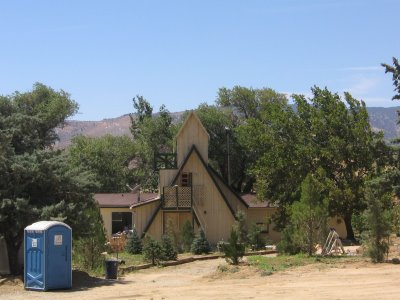
A seemingly ageless, “been there” kind of guy, he writes, directs, stars in, scores and produces his films. He is also a martial arts expert and a Christian music recording artist.
Like the man himself, the house extends far past its humble exterior. As his films and ambitions have dictated, David has built on to the house, creating an M.C. Escher-esque labyrinth of white doors, arbitrarily shaped rooms and staircases to nowhere. A studio exists adjacent to this house, festooned with David’s movie posters and filled with used set pieces. Outside he has built a pond from an underground spring, presumably to expand his shooting locations.
His films are made in six weeks and then distributed by a major video store chain. “Straight to video,” a term synonymous in some circles with “factory second” or “thrift store,” is in this case the deliberate objective. Make a film for $10,000. Sell it to the video stores for between $50,000 and $250,000. Lather, rinse, repeat.
But it can be hard to repeatedly churn out movies on the cheap. Most actors crave meaty roles in tightly written scripts. And they want to be paid. Most crew members hate their jobs because they’re really paying their dues on the road to a director’s chair. And they want to be paid.
The more you develop your crew, the more compensation they expect. They expecxt to work in higher quality productions, too.
David manages to keep his costs down in several ways. First, he owns his own studio. Second, he doesn’t’ have to pay anyone for screenplays—he does it himself. Third, his actors perform double duty behind the camera as assistant directors, script readers and craft services.
Fourth and most importantly, he doesn’t pay them for either role.
David has harnessed the informational power of the Internet. Because of this, he gets his cast for free.
Experience has always been a hot commodity in moviemaking, a business in which untold numbers of projects go unfinished because they run out of funds or their creative leaders part ways or their creators just lose interest. Having a verifiable film credit to your name is like a merit badge, a permanent association with a project which, even if it tanked, actually saw the light of day. A film credit is an endorsement. While this has always been so, verifying it was much more difficult before the Internet. The Internet Movie Database stores information on nearly every movie ever made (and officially distributed). Even straight-to-video movies show up there. David should know. He’s got more than 25 entries.
While the Internet is a lure to fresh talent, David also finds it a useful medium for revenue. He advertises for crew on craigslist.org, but he also gets the chance to select potential cast members when people sign up for his $75 acting seminars (“Wrote, directed and starred in over 25 films!”), held in his private studio.
Apart from the cast, everything gets recycled—set pieces, wardrobe, locations—with no room for perfectionism. David has his house rebuilt for each shoot. Amateur actors perform their best while trying to keep the shambolic production afloat, compromises piled atop compromises like so many mattresses, until there’s 100 minutes of movie. But it gets done.
Somebody must rent these films. The distribution contracts don’t pay David for units rented, of course, but people must rent the movies for the stores to keep paying him for his product. And don’t tell me it’s a bunch of irony-minded twentysomethings looking to play “Mystery Science Theater 3000.” I don’t believe that’s the target audience.
When they reach the shelves, some shell-shocked consumer must reach out a numb hand and grab the drab jewel case. The thing is, we exist in a branded world. Brands define our culture. We feel more comfortable with name-brand soda, name-brand cereal, even the name-brand electronics that play our entertainment.
And certainly our celebrities are brands, with their own marketing schemes and demographic appeal. So who is left anywhere who would earnestly consume these generic products? For the same price as a recognizable brand, who would take this off the shelf?
 Beaker Chronicles
Beaker Chronicles